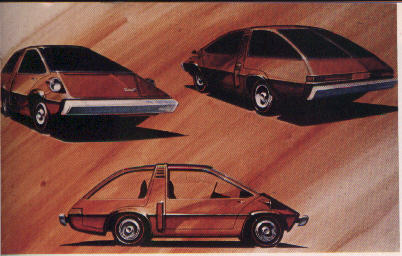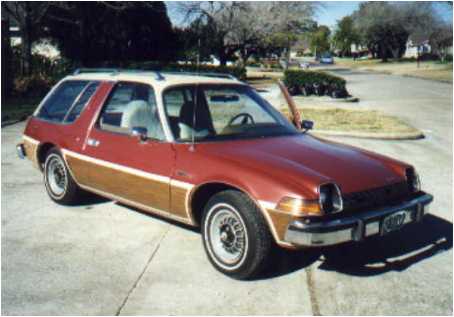In the eyes of the beholder
By Grant Yoxon
Ed Urzi has an opinion about
ugly cars. Judging by the number of times I see links to his Really
Ugly Cars of the Post-War Period page, quite a few others share his
opinion.
On Ed's list of really ugly
cars is the 1950 Saab 92, 1960 Plymouth Valiant, 1958 Messerschmitt Tiger,
1955-75 Citroen DS, 1975 Datsun S10, 1962-67 Amphicar, 1958 Ford Edsel
and, according to Ed, "the piece de resistance of automotive
ugliness," the AMC Pacer.

Built between 1975 and 1980,
the Pacer was no doubt unusual. Likened by automotive writers at the time
to an egg on wheels, a rolling greenhouse or a moon buggy, the AMC Pacer
was short - 435 cm - and about as wide as a Cadillac - 196 cm.
American Motors promoted the
car with the slogan, "You only ride like a Pacer if you're wide like
a Pacer."
While the car was criticized
for it's unusual shape, it was at the same time praised for its innovative
approach to passenger comfort and convenience. Wide had its advantages.
The car would seat five passengers comfortably. Huge glass areas gave
great visibility. Fully 37% of the car's surface area was glass. The side
windows curved around the back of the car where a big rear door allowed
good trunk accessibility. The doors were big-car wide as well, providing
easy entry. The passenger door, for some reason, was 10cm longer than the
driver's door.
 The idea of the pacer began in 1971 with some design sketches made by
Richard Teague, then AMC's vice president of design. These early sketches,
which can be found at AMC
Pacer: The Full Story, show a vehicle far more radical than the final
production car, with a short hood forming one continuous line with the
windshield. The car went through numerous changes and various prototypes
before emerging as the 1975 Pacer. All these stages are documented in an
extensive photographic essay which Switzerland resident Pascal Monney has
compiled for AMC Pacer: the Full Story.
The idea of the pacer began in 1971 with some design sketches made by
Richard Teague, then AMC's vice president of design. These early sketches,
which can be found at AMC
Pacer: The Full Story, show a vehicle far more radical than the final
production car, with a short hood forming one continuous line with the
windshield. The car went through numerous changes and various prototypes
before emerging as the 1975 Pacer. All these stages are documented in an
extensive photographic essay which Switzerland resident Pascal Monney has
compiled for AMC Pacer: the Full Story.
Wolfgang Mederle is another
European AMC fan, who has documented the history of American Motors and
the Pacer at www.mederle.de. According
to Mr. Mederle, the Pacer was originally intended to be revolutionary in
all respects, with rack and pinion steering, electronic ignition and
powered by a Wankel rotary engine on a front-wheel drive platform.
The Wankel was to have been
sourced from General Motors, but GM was unable to get the motor certified
for emissions and pulled the plug on the rotary engine program after AMC
was committed to building the new Pacer.
Unable to start over again, AMC
made some changes to the body design to accommodate its main power plant,
the 3.8 litre six. With this motor, front wheel drive was out of the
question and an additional six inches was added to the car's width to
accommodate the drive shaft for rear wheel drive.
Obviously not all people think,
like Ed Urzi, that the Pacer is the ugliest car in the post-war period.
There is a small contingent of online enthusiasts devoted to the AMC
Pacer.
See for example Jennifer
Barovian's Pacer Page,
which is acknowledged among Pacer fans as the centre of Pacer mania on the
Web. The site provides the essential links to Pacer resources, technical
info and other Pacer sites.
Follow a few links from this
site and you will come across the Washington
Grove Pacer Farm, Shaun Boyd's Pacer
Paradise and Gary's 1976
Pacer. This latter page is simply a picture of Gary, his car and the
message: "I put $3,000 into it and sold it for $450. Imagine having
someone with that kind of business savvy on your team."
There is one thing Pacer owners
share besides a taste for unusual transportation - a sense of humor.
But Ed Urzi isn't joking when
he writes, "While AMC somehow managed to sell over a quarter million
Pacers during it's 5½ year model run, the Pacer is also widely credited
with being the car that eventually killed AMC as a
corporation."
Over 280,000 Pacers were sold
between 1975 and 1980 when production stopped. However, 145,500 of those
were sold in the first year and AMC needed to sell that number in the
first five years just to break even on tooling for the car. Sales declined
from 117,000 in 1977 to only 11,000 in 1979.

AMC tried to respond by adding a station wagon to the
lineup in 1977 and by increasing horsepower. A V-8 was produced in 1978
and ‘79 but only 3528 were sold.
Maybe Ed Urzi was right after
all: "Now we almost always root for the little guy here at Ed's Home
Page, and as the smallest American auto manufacturer, we mourned AMC's
demise as a corporate entity in 1987. However, the point could well be
made that any company producing a car as ugly as the Pacer (and the
Marlin, and the Gremlin, and the Matador, for that matter), probably
deserved to die."  |